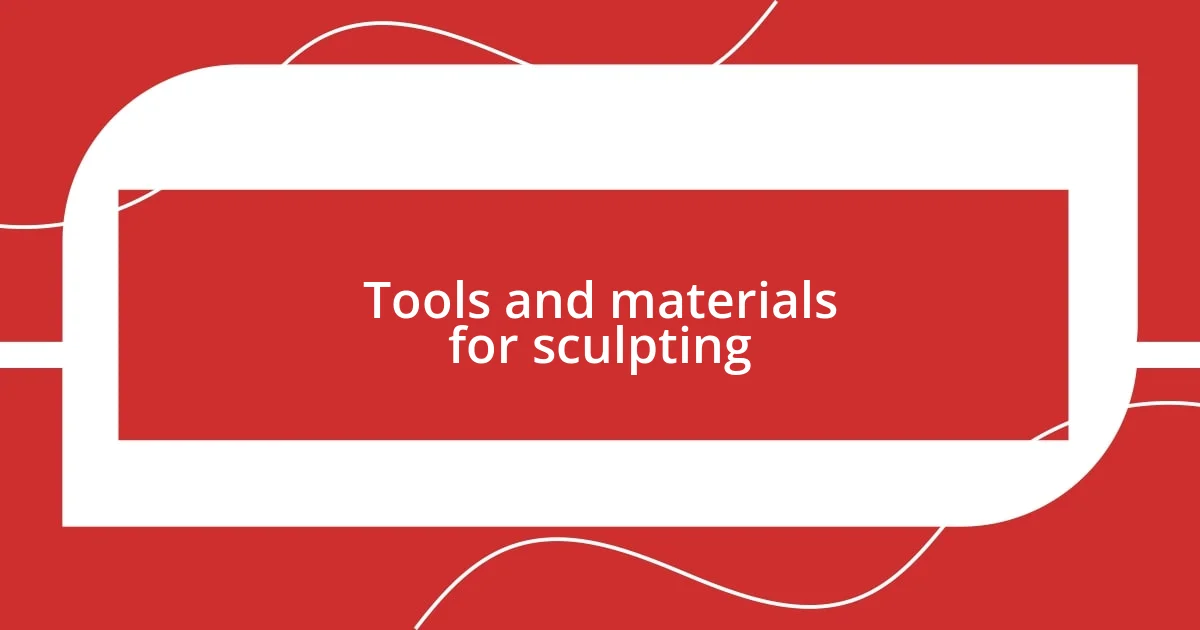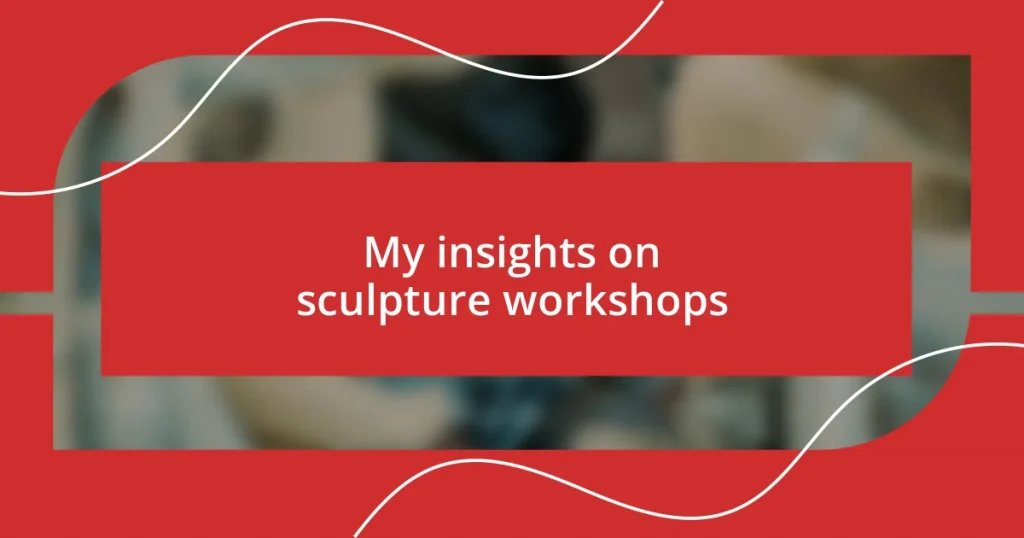Key takeaways:
- Sculpture workshops promote creative expression and community, offering a supportive environment for participants to share ideas and experiences.
- Choosing the right workshop is crucial; factors like instructor experience, materials provided, and class size greatly influence the learning experience.
- Maximizing your workshop experience involves collaboration, maintaining a sketchbook for ideas, and embracing mistakes as opportunities for growth.

Understanding sculpture workshops
Sculpture workshops are not just about learning techniques; they’re an immersive experience that combines creativity with hands-on skill development. I remember my first workshop vividly—the scent of clay mixed with excitement filled the air as I watched an artist shape raw material into something extraordinary. Isn’t it fascinating how something so simple can take on life through our hands?
Participating in these workshops offers a unique opportunity to connect with a community of like-minded individuals. I often found myself sharing ideas and struggles with fellow participants, creating a supportive environment. Have you ever considered how much our experiences can enrich our work? It’s that shared passion and exploration that often sparks the most incredible moments of inspiration.
Understanding sculpture workshops means embracing the journey of exploration and self-discovery. Each session challenges you to push beyond your limits and express your emotions through your creations. I still recall the feeling of triumph when my piece finally came together—it’s in these moments that you realize how sculpture can be a true reflection of one’s inner self.

Benefits of attending workshops
Attending sculpture workshops brings numerous benefits that go beyond just learning how to mold clay. I remember when I tried my hand at stone carving; the first few strokes were challenging. Yet, the moment I saw the shape emerge, it sparked a joy unlike any other. It’s empowering to transform a solid block into something personal. This connection to the material can truly enhance your creative expression.
Moreover, workshops foster a sense of camaraderie. During one session, I found myself working alongside a retiree who had always dreamed of creating art. We exchanged stories and techniques, which made the learning process feel less daunting. It was incredible to realize that age or experience level didn’t matter; our shared passion for sculpture brought us together. Isn’t it remarkable how art can unite people in such a profound way?
Another key benefit is the expert guidance you receive. I recall being stuck on a certain technique and feeling frustrated, but my instructor offered targeted advice that clicked instantly. That moment of insight not only improved my skills but also deepened my understanding of the craft. Having someone with experience to lean on can significantly fast-track your artistic journey and helps prevent common mistakes along the way.
| Benefit | Personal Experience |
|---|---|
| Creative Expression | Transforming materials into art sparks joy and empowerment. |
| Camaraderie | Bonding with fellow participants creates a supportive and inspiring environment. |
| Expert Guidance | Invaluable insights from instructors can quickly improve your skills. |

Choosing the right workshop
Choosing the right sculpture workshop can significantly impact your experience and growth as an artist. Consider your skill level and interests when selecting a workshop. I once signed up for a class that was too advanced for me, and while I learned a lot, I felt overwhelmed. It taught me the importance of finding a workshop that aligns with my current abilities and creative aspirations.
Here are some key factors to keep in mind when choosing a workshop:
-
Instructor Experience: Evaluate the background and style of the instructor. I’ve attended workshops led by both established artists and passionate teachers; both provided invaluable insights but in different ways.
-
Materials Provided: Check if the workshop includes all necessary materials. I recall a workshop where we had to bring our own supplies, which added unnecessary stress.
-
Class Size: Smaller classes often provide more individual attention, allowing for personalized guidance. I’ve had the best learning experiences in intimate settings where everyone got to know one another.
-
Focus Area: Determine whether you want to explore a specific technique, such as carving or modeling. I once took a general workshop that left me wanting more depth in a particular technique.
-
Community Vibe: Look for workshops that emphasize collaboration and support. I’ve found that connecting with fellow sculptors can ignite fresh ideas and foster creativity.
Taking the time to assess these elements can ensure that you select a workshop that truly resonates with your artistic journey.

Essential skills for sculptors
Understanding the essential skills for sculptors is crucial for any aspiring artist. One of the foundational skills is tactile sensitivity—the ability to feel and manipulate your materials effectively. I still remember my first encounter with clay; it felt foreign yet inviting beneath my hands. Developing a connection with your medium not only enhances your technique but also instills a sense of confidence in your creative decisions.
Another important skill is visualization. Sculptors must envision the final piece before it’s even begun. During one of my projects, I struggled to translate my mental image into reality, but I learned that sketching these ideas out first can help. It’s fascinating how a simple drawing can serve as a map, guiding you through the intricate process of transforming raw materials into art.
Lastly, patience plays a pivotal role in sculpting. The process can be slow, with many details requiring careful attention. I’ve had moments where I was ready to rush through just to see results, but practicing patience taught me the value of taking a step back. How often do we push ourselves to finish quickly, only to lose sight of the artistry involved? Embracing the journey rather than fixating on the destination can truly elevate your work.

Tools and materials for sculpting
When it comes to sculpting, having the right tools is essential for creating your vision. I remember the first time I walked into a workshop and was introduced to various sculpting tools—chisels, rasps, and wire tools. Each tool had a distinct purpose, and I quickly learned that using the right one could dramatically change the way I interacted with my medium. Have you ever struggled to create a detail, only to realize the tool you were using was all wrong? It’s a humbling experience, but one that drives home the importance of tool selection.
The materials you choose to work with also play a significant role in your sculpting journey. In my early days, I experimented with a wide range, from clay to stone and even wood. Each material offers unique challenges and rewards. I found that while clay allowed for spontaneous creativity, stone demanded patience and precision. It’s like having a conversation with each medium—discovering what it can do while learning to navigate its limitations. Are you more drawn to the immediacy of clay or the durability of stone? Each choice reflects your artistic voice and intent.
Lastly, don’t overlook the importance of safety gear when working with certain materials. I learned this the hard way during a stone carving session when I neglected to wear proper eye protection. A small chip flew off and reminded me just how crucial it is to prioritize safety alongside creativity. It’s easy to get lost in the process, but taking a moment to ensure you’re equipped with gloves, goggles, and masks can save you from unexpected mishaps. Isn’t it better to create with peace of mind rather than worry about accidents? Fostering a safe work environment ultimately enhances your ability to express yourself through sculpture.

Tips for maximizing your experience
When attending sculpture workshops, one of the best tips I can offer is to embrace the spirit of collaboration. I vividly recall a workshop where we were all encouraged to share our progress and ideas. The feedback I received from fellow sculptors often sparked new perspectives I hadn’t considered. Have you ever listened to a peer and realized your work could shift in a direction you hadn’t even imagined? Engaging with others not only enhances your learning but also creates a supportive community that can drastically improve your experience.
Another key to maximizing your experience in these workshops is to keep a sketchbook handy. I can’t stress this enough. During a recent workshop, ideas struck me at the most unexpected moments, and I found myself sketching in the margins of my notes just to capture that fleeting inspiration. These sketches became invaluable when decisions about my sculpting direction were needed later in the process. It’s as if the simple act of drawing freed my creative flow and kept my thoughts organized. So, why not dedicate a section of your sketchbook to jot down thoughts, inspirations, and even mistakes? It can be a treasure trove of insights for future projects.
Lastly, don’t hesitate to make mistakes. Early in my artistic journey, I often viewed every misstep as a failure. However, through more workshops, I learned to approach these blunders as vital learning experiences. One time, a sculpture I created tragically collapsed, but it forced me to rethink my structural techniques entirely. If I had shied away from taking risks, I wouldn’t have discovered more about my artistic voice. So, why not lean into those moments? Instead of fearing errors, let them teach you and shape your art in ways you never expected. Embracing vulnerability in your creative process can lead to unexpected breakthroughs, don’t you think?

Showcasing your finished work
Once you’ve completed your sculpture, the next thrilling step is showcasing your finished work. I remember the first time I unveiled my piece at a local art show. The rush of energy in the room, mixed with my nervous anticipation, made my heart race. What about you? Have you ever felt that exhilarating mix of pride and vulnerability when sharing your creations? It’s an experience that can be both empowering and humbling.
Presentation matters too. I learned this the hard way during a group exhibition when my piece was nearly obscured by chaotic decorations. After that, I made it a point to consider the background and lighting for each display. Clear, simple settings can enhance the viewer’s appreciation of your work. How do you want your art to speak for itself? A clean presentation can allow each delicate detail to shine, inviting viewers to connect with your vision on a deeper level.
Lastly, engaging with your audience while showcasing your sculpture can transform the experience. I often find that sharing the story behind my piece enriches the viewer’s understanding. When someone asks about my inspiration, it reignites the passion I felt during the sculpting process. Isn’t it fascinating how a conversation can deepen the connection to your work? By inviting others into your creative journey, you not only showcase your art but also foster a sense of community around it.















